Numerical Investigation of the Wan’an Bridge Fire and the Protection Effect of Intumescent Flame-Retardant Coatings
Abstract
1. Introduction
2. Wan’an Bridge Fire
2.1. Bridge Structure
2.2. Development of Fire
2.3. Cause of Fire
3. Fire Simulation
3.1. Model Description
3.1.1. Complex Wood Pyrolysis Model
3.1.2. Combustion Model
3.1.3. Heat Transfer Model
3.2. Numerical Setup
3.2.1. Architectural Model and Grid
3.2.2. Fire Source
3.2.3. Boundary and Initial Conditions
4. Results and Discussion
4.1. Simulation Results Without Flame-Retardant Coatings
4.2. Simulation Results with Flame-Retardant Coatings
5. Conclusions
Author Contributions
Funding
Institutional Review Board Statement
Informed Consent Statement
Data Availability Statement
Acknowledgments
Conflicts of Interest
Nomenclature
| Symbol | Description | Unit |
| Activation energy | ||
| Peak reaction rate | ||
| Frequency factor | ||
| Gas constant | ||
| Mass fraction of reacting material | ||
| Temperature | ||
| Peak temperature | ||
| Heating rate | ||
| Temperature difference | ||
| Yield of solid residue | ||
| Density of the material | ||
| Specific heat capacity of the material | ||
| Thermal conductivity of the material | ||
| Temperature of the solid | ||
| Time | ||
| Heat production rate | ||
| Convective heat flux | ||
| Radiative heat flux |
References
- The Wan’an Bridge—The Longest Wooden Arched Corridor Bridge in China Originally Built During the Northern Song Dynasty Was Destroyed by Fire. Available online: http://finance.sina.com.cn/jjxw/2022-08-07/doc-imizmscv5170237.shtml (accessed on 28 April 2025). (In Chinese).
- Wan’an Bridge. Available online: https://baike.baidu.com/item/%E4%B8%87%E5%AE%89%E6%A1%A5/5149574?fr=aladdin (accessed on 28 April 2025). (In Chinese).
- Wuyishan Yuqing Bridge Fire Incident. Available online: https://news.ifeng.com/c/7fZm9at4PzN (accessed on 28 April 2025). (In Chinese).
- The 500-Year-Old Buyue Bridge in Jianou, Fujian Province, Was Burned Down, the Cause of the Fire Is Under Investigation. Available online: https://www.thepaper.cn/newsDetail_forward_2939781 (accessed on 28 April 2025). (In Chinese).
- Chongqing Qianjiang Zhuoshui Ancient Town’s Fengyu Covered Bridge Destroyed by Fire. Available online: https://war.163.com/photoview/00AP0001/40509.html#p=9EPDNBJ200AP0001 (accessed on 28 April 2025). (In Chinese).
- Canadian Wooden Trestle Bridge Destroyed in Spectacular Fire in Alberta’s Mayerthorpe. Available online: https://www.abc.net.au/news/2016-04-28/wooden-trestle-bridge-destroyed-in-spectacular-fire/7365688 (accessed on 28 April 2025).
- Wells, N.; Moon, R.E. Wood Swelling: Pressures exerted from saturated wood materials. In Forensic Engineering; American Society of Civil Engineers: Reston, VA, USA, 2015; pp. 209–218. [Google Scholar] [CrossRef]
- Tolvaj, L.; Varga, D. Photodegradation of timber of three hardwood species caused by different light sources. Acta Silv. Lignaria Hung. 2012, 8, 145–156. [Google Scholar] [CrossRef]
- Zborowska, M.; Niedzielski, P.; Budka, A.; Enenche, J.; Mleczek, M. Content of elements in contemporary and archaeological wood as a marker of possible change in physico-chemical parameters. J. Cult. Herit. 2023, 63, 90–100. [Google Scholar] [CrossRef]
- Borgin, K.; Parameswaran, N.; Liese, W. The effect of aging on the ultrastructure of wood. Wood Sci. Technol. 1975, 9, 87–98. [Google Scholar] [CrossRef]
- Lowden, L.A.; Hull, T.R. Flammability behaviour of wood and a review of the methods for its reduction. Fire Sci. Rev. 2013, 2, 4. [Google Scholar] [CrossRef]
- Guibaud, A.; Mindeguia, J.C.; Albuerne, A.; Parent, T.; Torero, J. Notre-Dame de Paris as a validation case to improve fire safety modelling in historic buildings. J. Cult. Herit. 2023, 65, 145–154. [Google Scholar] [CrossRef]
- You, D.; Wang, X.Z.; Chen, W.J.; Wu, G.X. Numerical simulation analysis of smoke control and flow for large building fire. Appl. Mech. Mater. 2014, 608–609, 61–65. [Google Scholar] [CrossRef]
- Binbin, W. Comparative research on fluent and fds’s numerical simulation of smoke spread in subway platform fire. Procedia Eng. 2011, 26, 1065–1075. [Google Scholar] [CrossRef]
- Mohan, R.; Sundararaj, S.; Thiagarajan, K.B. Numerical simulation of flow over buildings using OpenFOAM®. AIP Conf. Proc 2019, 2112, 020149. [Google Scholar] [CrossRef]
- Shen, T.; Huang, Y.; Chien, S. Using fire dynamic simulation (FDS) to reconstruct an arson fire scene. Bldg. Environ. 2008, 43, 1036–1045. [Google Scholar] [CrossRef]
- Chang, W.Y.; Tang, C.H.; Lin, C.Y. Estimation of magnitude and heat release rate of fires occurring in historic buildings-taking churches as an example. Sustainability 2021, 13, 91–93. [Google Scholar] [CrossRef]
- Wang, X.Y.; Wang, J.; Wang, J.H.; Sheng, G.H. Experimental and numerical simulation analyses of flame spread behaviour over wood treated with flame retardant in ancient buildings of fuling mausoleum, China. Fire Technol. 2022, 61, 1053–1077. [Google Scholar] [CrossRef]
- Huang, Y.H. The use of parallel computing to accelerate fire simulations for cultural heritage buildings. Sustainability 2020, 12, 10005. [Google Scholar] [CrossRef]
- Zhou, B.; Zhou, X.M.; Chao, M.Y. Fire protection of historic buildings: A case study of group-living yard in Tianjin. J. Cult. Herit. 2012, 13, 389–396. [Google Scholar] [CrossRef]
- Zhang, F.; Shi, L.; Liu, S.; Shi, J.; Shi, C.; Xiang, T. CFD-based fire risk assessment and control at the historic dong wind and rain bridges in the western Hunan region: The case of Huilong bridge. Sustainability 2022, 14, 12271. [Google Scholar] [CrossRef]
- Gomez Mares, M.; Tugnoli, A.; Landucci, G.; Barontini, F.; Cozzani, V. Behavior of intumescent epoxy resins in fireproofing applications. J. Anal. Appl. Pyrol. 2012, 97, 99–108. [Google Scholar] [CrossRef]
- Griffin, G.J. The modeling of heat transfer across intumescent polymer coatings. J. Fire Sci. 2010, 28, 249–277. [Google Scholar] [CrossRef]
- Zhang, Y.; Wang, Y.C.; Bailey, C.C.; Taylor, A.P. Global modelling of fire protection performance of an intumescent coating under different furnace fire conditions. Fire Saf. J. 2012, 31, 51–72. [Google Scholar] [CrossRef]
- Cirpici, B.K.; Wang, Y.C.; Rogers, B. Assessment of the thermal conductivity of intumescent coatings in fire. Fire Saf. J. 2016, 81, 74–84. [Google Scholar] [CrossRef]
- Hao, J.; Chow, W.K. A brief review of intumescent fire retardant coatings. Archit. Sci. Rev. 2003, 46, 89–95. [Google Scholar] [CrossRef]
- Bar, M.; Alagirusamy, R.; Das, A. Flame retardant polymer composites. Fibers Polym. 2015, 16, 705–717. [Google Scholar] [CrossRef]
- Mohd Sabee, M.M.S.; Itam, Z.; Beddu, S.; Zahari, N.M.; Mohd Kamal, N.L.; Mohamad, D.; Zulkepli, N.A.; Shafiq, M.D.; Abdul Hamid, Z.A. Flame retardant coatings: Additives, binders, and fillers. Polymer 2022, 14, 2911. [Google Scholar] [CrossRef] [PubMed]
- McGrattan, K.; McDermott, R.; Weinschenk, C.; Forney, G. Fire Dynamics Simulator Users Guide, 6th ed.; Special Publication (NIST SP); National Institute of Standards and Technology: Gaithersburg, MD, USA, 2013. [CrossRef]
- Yan, H.; Zhu, G.; Zhao, Y. Study on pyrolysis characteristics of Chinese fir under different natural aging times. Fire 2022, 5, 161. [Google Scholar] [CrossRef]
- Yue, K.; Wu, J.; Xu, L.; Tang, Z.; Chen, Z.; Liu, W.; Wang, L. Use impregnation and densification to improve mechanical properties and combustion performance of Chinese fir. Constr. Build. Mater. 2020, 241, 118101. [Google Scholar] [CrossRef]
- Ira, J.; Hasalová, L.; Šálek, V.; Jahoda, M.; Vystrčil, V. Thermal analysis and cone calorimeter study of engineered wood with an emphasis on fire modelling. Fire Technol. 2020, 56, 1099–1132. [Google Scholar] [CrossRef]
- Koraïem, M.; Assanis, D. Wood stove combustion modeling and simulation: Technical review and recommendations. Int. Commun. Heat. Mass. 2021, 127, 105423. [Google Scholar] [CrossRef]
- Dai, X.; Gamba, A.; Liu, C.; Anderson, J.; Charlier, M.; Rush, D.; Welch, S. An engineering CFD model for fire spread on wood cribs for travelling fires. Adv. Eng. Softw. 2022, 173, 103213. [Google Scholar] [CrossRef]
- Yang, D.; Hu, L.H.; Jiang, Y.Q.; Huo, R.; Zhu, S.; Zhao, X.Y. Comparison of FDS predictions by different combustion models with measured data for enclosure fires. Fire Saf. J. 2010, 45, 298–313. [Google Scholar] [CrossRef]
- Yu, Z.; Xu, X.; Fan, L.; Hu, Y.; Cen, K. Experimental measurements of thermal conductivity of wood species in China: Effects of density, temperature, and moisture content. For. Prod. J. 2011, 61, 130–135. [Google Scholar] [CrossRef]
- Wang, J.; Hou, S.; Shen, Z.; Wen, J.; Qi, C. Thermal characteristics and simulation of enzymatic lignin isolated from Chinese fir and birch. Forests 2022, 13, 914. [Google Scholar] [CrossRef]
- Shi, L.; Chew, M.Y.L. A review of thermal properties of timber and char at elevated temperatures. Indoor Built Environ. 2023, 32, 9–24. [Google Scholar] [CrossRef]
- Zhu, Y.; Zhang, F.; Xing, L.; Xie, W.; Cheng, Y. Construction and verification of a heat transfer model for intumescent coatings. Prog. Org. Coat. 2022, 167, 106868. [Google Scholar] [CrossRef]
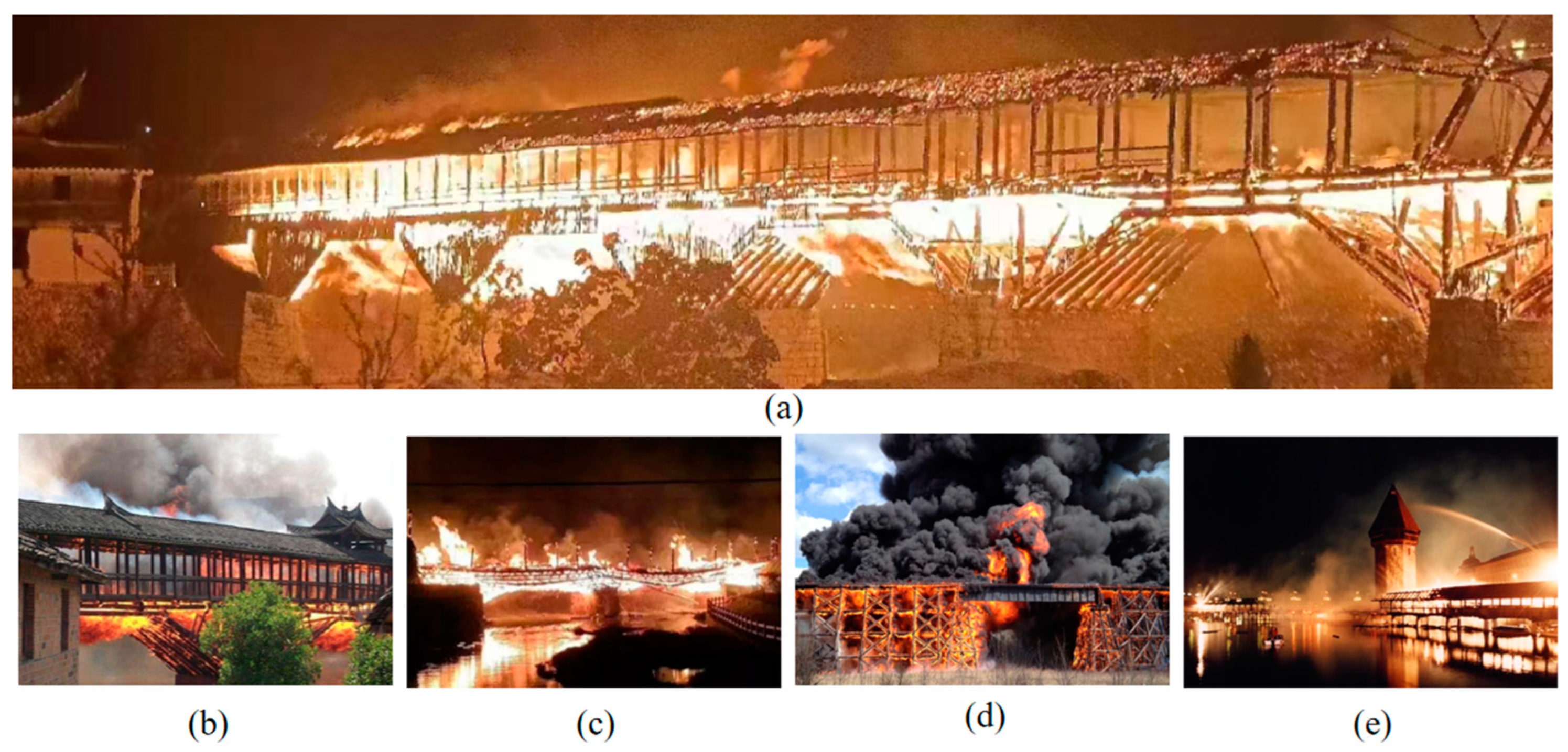




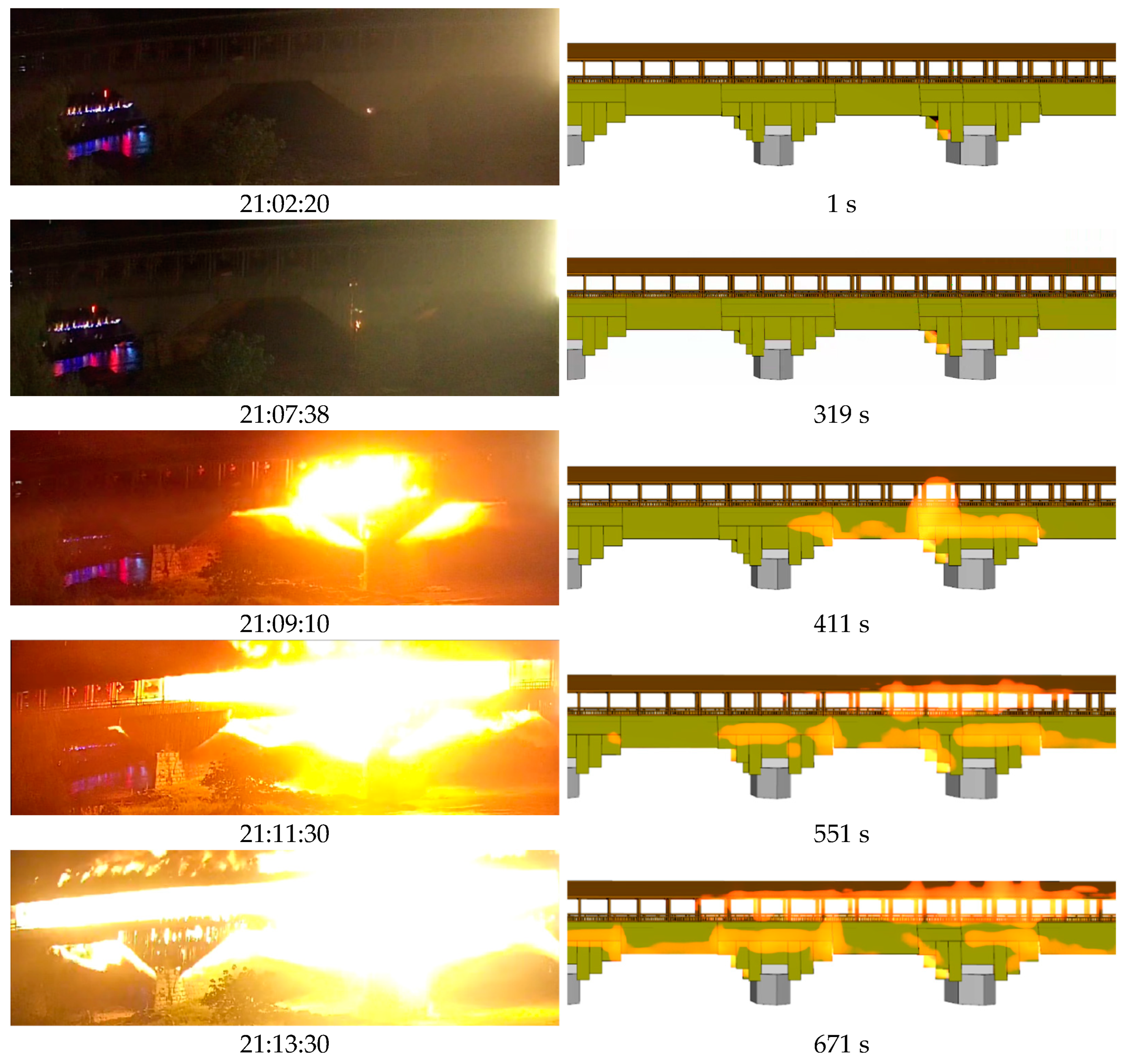
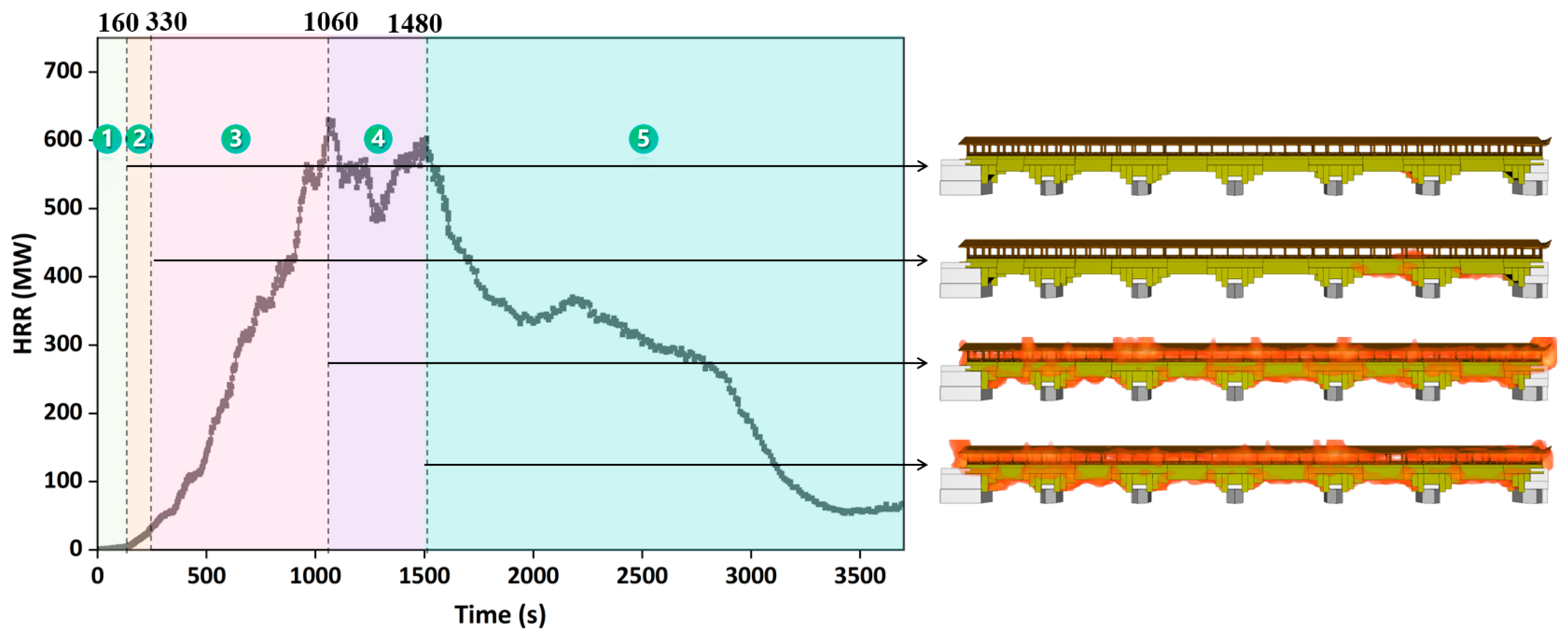
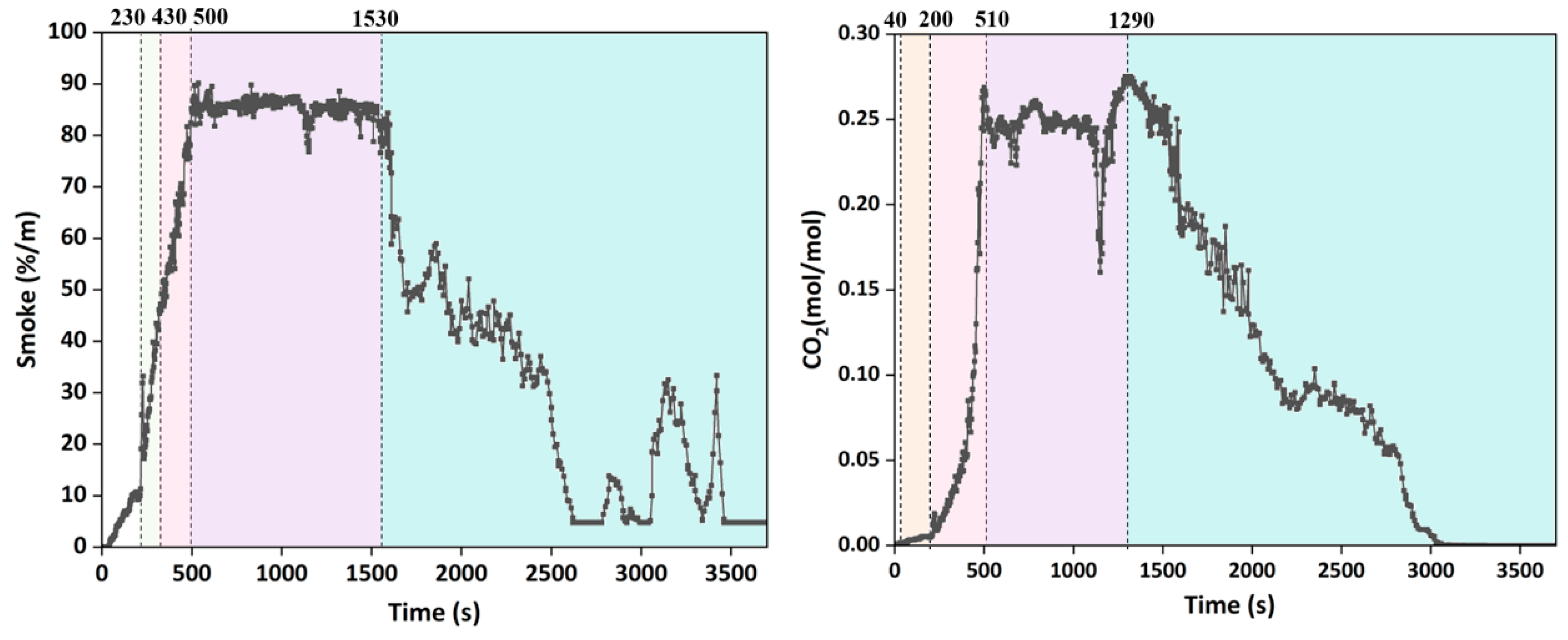

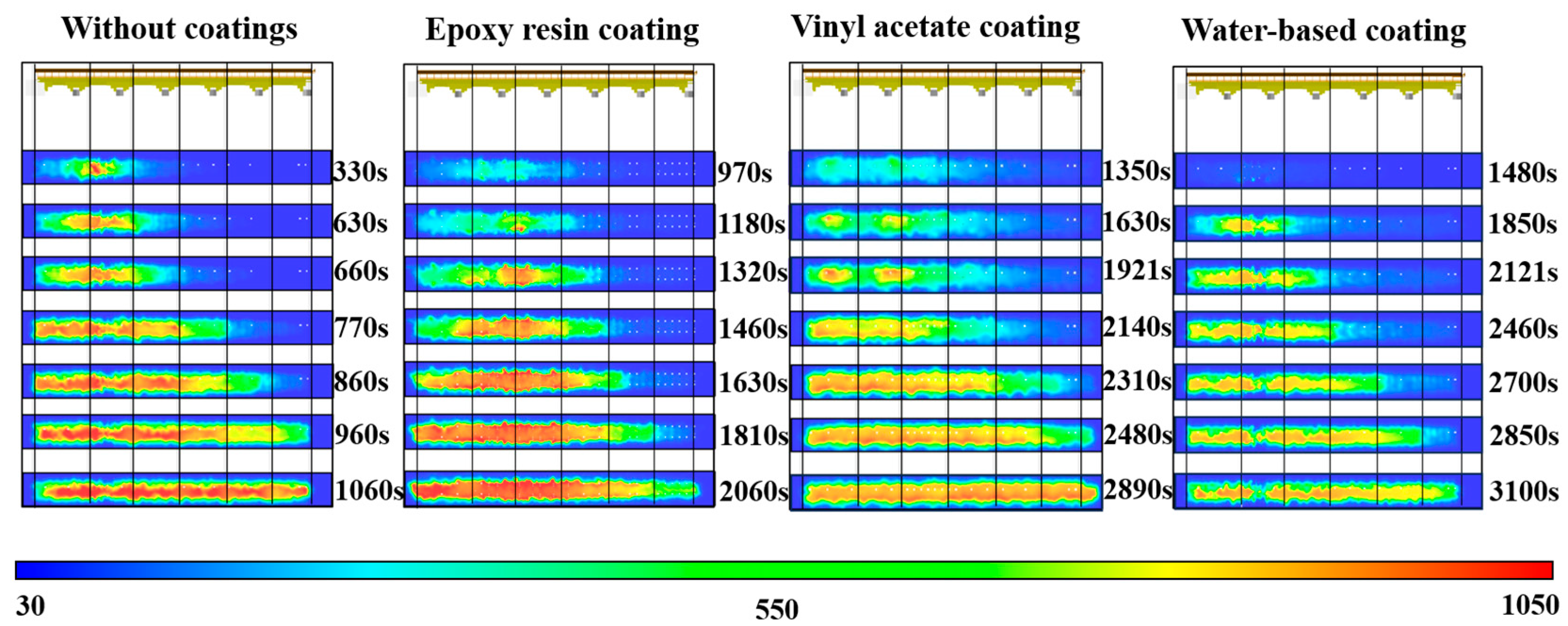
| Thermal Properties | Unit | Input Value | Literature |
|---|---|---|---|
| K | 623 | [30] | |
| 5 | [30] | ||
| K | 150 | [28] | |
| Mass loss | % | 75.06 | [31] |
| Combustion heat | 11.88 | [32] |
| Parameter | Input Value | Literature |
|---|---|---|
| 308.3 | [36] | |
| 0.07538 + 0.0001681 T | [37] | |
| 0.5 | [36] | |
| 1800 | [38] | |
| −0.79528 + 5.98 × 10−3 T − 3.8 × 10−6 T2 | [38] | |
| 0.091 + 8.2 × 10−5 T | [38] |
| IFR Coating | Experimental Basis | Stage |
Temperature Range (°C) | Thermal Conductivity | Expansion Ratio |
|---|---|---|---|---|---|
| Epoxy resin [22] | TGA TG-DSC-FTIR The fixed-bed tubular reactor | ||||
| Vinyl acetate [23] | TGA/DSC cone calorimeter | ||||
| Water-based [24,25] | TGA cone calorimeter | ||||
| TYPE | (s) | Change * (%) | (s) | Change * (%) | ||||
|---|---|---|---|---|---|---|---|---|
| Without coatings | 120 | - | 630 | - | 1060 | - | 0.0063 | - |
| Epoxy resin coating | 700 | +580 | 515 | −18 | 2070 | +1010 | 0.0044 | −30 |
| Vinyl acetate coating | 1150 | +1030 | 477 | −24 | 2860 | +1800 | 0.0043 | −32 |
| Water-based coating | 1400 | +1280 | 413 | −34 | 3140 | +3080 | 0.0044 | −30 |
Disclaimer/Publisher’s Note: The statements, opinions and data contained in all publications are solely those of the individual author(s) and contributor(s) and not of MDPI and/or the editor(s). MDPI and/or the editor(s) disclaim responsibility for any injury to people or property resulting from any ideas, methods, instructions or products referred to in the content. |
© 2025 by the authors. Licensee MDPI, Basel, Switzerland. This article is an open access article distributed under the terms and conditions of the Creative Commons Attribution (CC BY) license (https://creativecommons.org/licenses/by/4.0/).
Share and Cite
Jiang, H.; Teng, J.; Wang, D.; Zhou, L.; Chen, Y. Numerical Investigation of the Wan’an Bridge Fire and the Protection Effect of Intumescent Flame-Retardant Coatings. Fire 2025, 8, 184. https://doi.org/10.3390/fire8050184
Jiang H, Teng J, Wang D, Zhou L, Chen Y. Numerical Investigation of the Wan’an Bridge Fire and the Protection Effect of Intumescent Flame-Retardant Coatings. Fire. 2025; 8(5):184. https://doi.org/10.3390/fire8050184
Chicago/Turabian StyleJiang, Huiling, Jie Teng, Dong Wang, Liang Zhou, and Yirui Chen. 2025. "Numerical Investigation of the Wan’an Bridge Fire and the Protection Effect of Intumescent Flame-Retardant Coatings" Fire 8, no. 5: 184. https://doi.org/10.3390/fire8050184
APA StyleJiang, H., Teng, J., Wang, D., Zhou, L., & Chen, Y. (2025). Numerical Investigation of the Wan’an Bridge Fire and the Protection Effect of Intumescent Flame-Retardant Coatings. Fire, 8(5), 184. https://doi.org/10.3390/fire8050184






